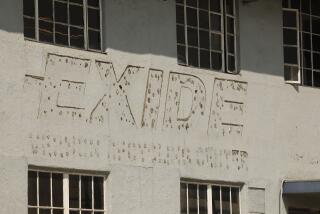Problems at A-Plant Near Denver Cited
- Share via
DENVER — A one-of-a-kind nuclear power station near here, similar in some ways to the damaged Soviet Chernobyl plant, has been plagued by safety-related problems in recent years, according to a report prepared for the U.S. Nuclear Regulatory Commission.
The report, published in March, said the Fort St. Vrain reactor--which is operated by the Public Service Co. of Colorado, a private utility--has often been shut down because of the “safety implications” of plant incidents. It added that many events that have not caused shutdowns “have raised safety-related concerns.”
The major problem at the plant has been the seepage of water into the reactor core, the report said. Faulty electrical systems and careless maintenance also have been among the facility’s shortcomings.
The reactor, 35 miles north of Denver, was built 15 years ago as a demonstration project and, because of its unique design, is often called the nation’s safest nuclear power plant.
35% of Capacity
But since it began operating commercially in 1976, the plant has been out of service almost as much as it has been producing power. Today, the plant is limited to 35% of capacity while its owners make repairs ordered by federal regulators.
The NRC report cited an incident in September, 1984, when the plant’s operators ignored alarms indicating that moisture had penetrated a space where steel piping passes through the thick concrete walls of the reactor vessel. Plant operators told the NRC that they ignored the alarms because the moisture detectors had been wrong in the past.
This time, though, the alarms were right. But the presence of moisture in the area was not discovered until the detectors were removed and water ran out. Two months later, testing revealed that the moisture had damaged a backup emergency shutdown system for the plant.
The most serious incident at Fort St. Vrain in recent years occured in June, 1984, when the moisture seepage problem led to conditions that automatically shut down the reactor. In that incident, six of the 37 control rods that are supposed to drop into the core to quell the nuclear reaction failed to insert automatically, a condition the report termed “a significant safety concern.”
2-Year Shutdown
The plant was shut down for almost two years while the utility corrected the problem.
Because the Colorado plant has some features in common with the crippled Soviet plant, which was damaged last week by a fire and presumed meltdown, a top official of the Public Service Co. was in Washington on Monday conferring with NRC officials about the reactor.
Darrell Eisenhut, deputy director of the NRC’s Office of Nuclear Reactor Regulation, who attended the meeting, said the agency had questions about the reactor’s graphite core and containment vessel, which in some ways are similar to the Chernobyl plant.
“We feel there are not any immediate problems or any need to take action on Fort St. Vrain,” Eisenhut said afterward.
As a so-called graphite moderated reactor, Ft. St. Vrain’s core is made of stacked graphite blocks that contain its fuel and “moderate” the nuclear reaction by absorbing excess heat. Unlike the Chernobyl plant, which also has a graphite core, Fort St. Vrain is cooled by helium gas. Chernobyl is cooled by water, which some experts believe may have combined with the graphite or the reactor fuel to cause the explosion that led to the Soviet disaster.
Ceramic-Coated Fuel
The Colorado plant also is unique because it uses a ceramic-coated uranium fuel that is much less susceptible to melting than the traditional metal-clad uranium fuel rods.
David Moses, an engineer at the Oak Ridge National Laboratory in Tennessee, who co-wrote the report on Fort St. Vrain, agreed that the plant’s design makes it safer than the more common pressurized water and boiling water reactors.
But Moses said that extra margin of safety--and the fact that the plant has been out of service so much of the time--may be all that has saved Fort St. Vrain from more serious problems.
Moses said the NRC has had to badger the utility to take care of matters that should be routine. Three times in the past five years, for example, welders working inside the reactor building have damaged cables because they failed to take simple safety precautions.
Mark Severts, a spokesman for Public Service Co., said Monday he has not seen the critical report, which was published in the March issue of Nuclear Safety, a quarterly journal prepared for the NRC by the Oak Ridge National Laboratory in Tennessee.
But Severts said the plant’s design makes it “most likely the safest nuclear power plant in the United States.”
The gas-cooling and ceramic-coated fuel make it virtually impossible that the plant’s graphite core, while similar to the one at Chernobyl, could catch fire, Severts said.
“Comparing the two plants is like comparing a bike to an automobile,” Severts said.
Panel Created
In Richland, Wash., meanwhile, the Department of Energy announced the creation of an 11-member panel to assess whether the lack of a containment building at its so-called N Reactor in eastern Washington poses a safety threat.
The panel, to begin work May 19, will also investigate the chances of a graphite fire, such as the one in Chernobyl. The N reactor also uses graphite to moderate the nuclear reaction.
Times staff writers Karen Tumulty in Washington and Larry B. Stammer in Richland, Wash., contributed to this story.
More to Read
Sign up for Essential California
The most important California stories and recommendations in your inbox every morning.
You may occasionally receive promotional content from the Los Angeles Times.










